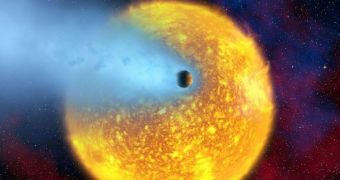Using funds from the US National Science Foundation (NSF) and the Natural Sciences and Engineering Research Council (NSERC) of Canada, investigators have recently detected an extrasolar planet that appears to be evaporating under the intense heat of its parent star.
The work was carried out by experts at the Cambridge-based Massachusetts Institute of Technology (MIT), the American space agency, and other organizations. The team says that the object in question is located around 1,500 light-years away from Earth.
Because it orbits so close to its parent star, the intense heat appears to be simply evaporating it. Estimates suggest that the world will not endure for longer than 100 million years, an extremely short time frame in astronomical terms.
Even now, the planet is followed in orbit by a comet tail-like cloud of debris, made out of materials removed from this alien world. The exoplanet is only slightly larger than Mercury, so it won't take its parent star too long to fully erode it.
Observations indicate that the star-facing half of the planet may be heated to temperatures as high as 3,600 degrees Fahrenheit (1,982ºC). The world, which orbits its star in just 15 hours, is believed to be tidally locked to its parent, like the Moon is to Earth.
Due to the intense heat, even the rocks making up the planet's surface melt and evaporate. They are then cast out of the atmosphere by intense winds, forming the world's tail. “We think this dust is made up of submicron-sized particles,” Saul Rappaport explains.
“It would be like looking through a Los Angeles smog,” adds the expert, who holds an appointment as a professor emeritus of physics at the Institute. Details of the new study appear in the latest issue of the esteemed Astrophysical Journal. The data were collected by the NASA Kepler Telescope.
The telescope observed that the brightness of the star KIC 12557548 was dipping once every 15 hours, but by varying intensities. After trying out several explanations, scientists decided that this is the scenario that best explains the readings.
“I’m not sure how we came to this epiphany. But it had to be something that was fundamentally changing. It was not a solid body, but rather, dust coming off the planet,” Rappaport concludes.

 14 DAY TRIAL //
14 DAY TRIAL //